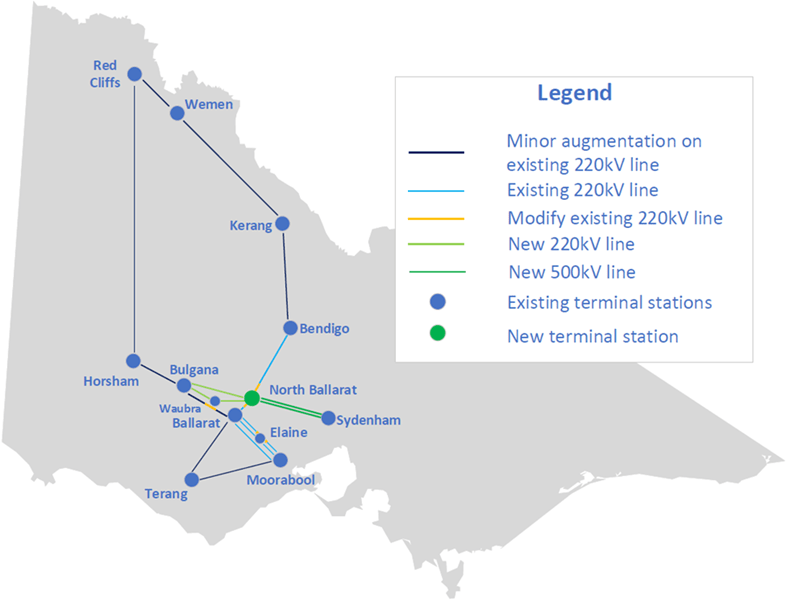The preferred investment option
Introduction
AEMO’s assessment of strategic investment in Western Victoria’s transmission network is projected to deliver $300 million of market benefits by unlocking future power system capabilities in the state, expanding the diversity and availability of energy supply, and reducing electricity costs for consumers over the long term.
The investment recommendation headlines AEMO’s Project Assessment Conclusions Report (PACR), the third and final report in the Regulatory Investment Test for Transmission (RIT-T) process, which presents the findings of an economic cost-benefit test to determine the preferred investment option to address current limitations in the Western Victoria transmission network, in accordance with the National Electricity Rules (NER).
With a potential for up to 6,000 megawatts (MW) of large-scale wind and solar generation to enter the area by 2030, urgent transmission network investment is required to reduce constraints on anticipated new and existing generation in Western Victoria.
Without adequate transmission capacity, generators connecting to this part of the network will become increasingly constrained, limiting the ability for existing and new generators to export power to the network, and impacting electricity costs over the long term.
PACR recommendation
The PACR recommends a combination of minor upgrades to existing infrastructure and major transmission works – including a new terminal station north of Ballarat and long-distance high voltage transmission lines between Bulgana and Sydenham terminal stations – staged over several years, with the final component expected to be in operation by 2025. This investment is estimated to cost $370 million, and will produce a total return of $670 million in market benefits, resulting in net benefits of $300 million.
This investment will deliver an increase in benefits to both energy consumers and energy producers, through significant reductions in the capital cost and dispatch cost of generation over the longer term. It will future-orient Victoria’s power system capabilities and supply availability, and help achieve a lowest cost portfolio of resources and strategic transmission development to meet consumer needs today, and into the future.
Critically, this project in Western Victoria is underpinned by AEMO’s Integrated System Plan (ISP), which seeks to optimise future generation and transmission development in the National Electricity Market (NEM) to ensure the ongoing reliability and security of the power system, at the least cost and risk to consumers.
This means making the most of existing resources and infrastructure while also planning for the full potential of new generation resources and technologies such as batteries, demand response and electric vehicles, so that we can enjoy a reliable, secure and affordable energy future.
As outlined in AEMO’s July 2019 ISP Insights Report and June 2019 Victorian Annual Planning Report (1.8 MB, pdf), this work is a first step in a series of planning studies and regulatory transmission investment tests underway to cost-effectively optimise transmission and infrastructure systems around the NEM.
The recommendation to increase transmission capacity in Western Victoria, as considered through this RIT-T, supports the delivery of reduced network congestion and facilitates more efficient connection and dispatch of generation in the region.
This transmission investment will support the development of major hubs for wind and solar energy in the region by strengthening transmission corridors to more efficiently transport large quantities of renewable energy to consumers. Key market benefits include fuel and capital cost savings as well as an improved capacity of the existing Victoria to New South Wales interconnector.
The PACR confirms the initial investment option proposed in AEMO’s Project Assessment Draft Report (PADR) (2.3 MB, pdf) published in December 2018. It is the culmination of more than two years’ investigation, including market modelling and broad stakeholder consultation, to identify the transmission investment option that maximises the net economic benefit to all those who produce, consume or transport electricity in the market in accordance with the NER. Of each of the credible options assessed through this process, the option recommended in the PACR delivers the highest net economic benefits across all scenarios and sensitivities.
At this early stage, the design and location of the new infrastructure required to deliver this investment has not been determined. While AEMO is responsible for planning the Victorian shared transmission network, it does not own any transmission infrastructure. AEMO is undertaking a competitive process to appoint a successful tenderer to design, build, own and operate the new infrastructure. The successful tenderer will undertake extensive investigations, and further stakeholder and community engagement, before any routes or locations are approved, and will be responsible for securing the necessary planning and environmental approvals to deliver the infrastructure. AEMO will provide updates on the tender process in late 2019.
AEMO acknowledges the important environmental, amenity, cultural and community matters raised by stakeholders through the RIT-T consultation process. These matters will be considered and addressed by the successful transmission system operator in delivering the project.
PACR executive summary
Further details on the recommended transmission investment as outlined in the PACR executive summary are provided below.
The full PACR is available for download.
For more information and to view the reports published to date as part of the Western Victoria RIT-T, visit AEMO’s dedicated webpage or contact us on 1800 845 044 or email WestVicRITT@aemo.com.au.
Excerpt from the Western Victoria Renewable Integration Regulatory Investment Test – Transmission: Project Assessment Conclusions Report Executive SummaryThis Project Assessment Conclusions Report (PACR) confirms the preferred option recommended in the Project Assessment Draft Report (PADR), and the updated information and assessment presented in this PACR has further strengthened this recommendation. Short term (present to 2021):
Medium term (2021 to 2025):
It is estimated to cost $370 million and deliver gross market benefits of $670 million and net market benefits of $300 million (all figures in present value). This net market benefit is achieved through:
|

Figure 1: Preferred option for Western Victoria Renewable Integration RIT-T
Note: the location of the proposed new terminal station and new transmission lines shown in this figure are illustrative only. Matters such as route selection will be considered after the conclusion of the RIT-T process.






